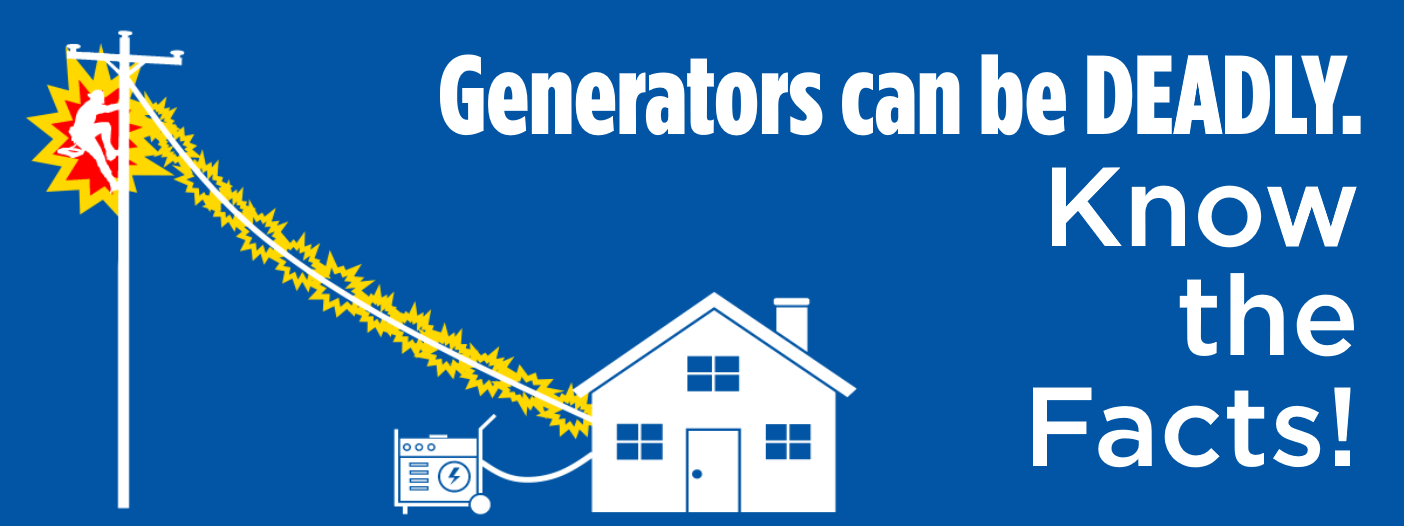
Generators can be deadly if connected incorrectly. Never connect a generator into a wall outlet or breaker panel on the interior or exterior of your home or business. Electricity can travel through your home or business back onto NLR Electric’s distribution system creating a life-threatening situation for both our employees as well as the general public. For help about generators, please contact us at 501-975-8888.
- Don’t attempt to backfeed your house
- Backfeeding means trying to power your home’s wiring by plugging the generator into a wall outlet.
- This reckless and dangerous practice presents an electrocution risk to utility workers and neighbors served by the same utility transformer.
- It also bypasses some of the built-in household circuit protection devices, so you could end up frying some of your electronics or starting an electrical fire.
- Install a transfer switch before the next storm
- This critical connection will cost from $500 to $900 with labor for a 5,000-rated-watt or larger generator.
- A transfer switch connects the generator to your circuit panel and lets you power hardwired appliances while avoiding the glaring safety risk of using extension cords.
- Most transfer switches also help you avoid overload by displaying wattage usage levels.
- Never run a generator in an enclosed space, in partly enclosed areas like a garage, or indoors. This can lead to Carbon Monoxide Poisoning.
- If you start to feel sick, dizzy, or weak while using a generator, get to fresh air RIGHT AWAY – DO NOT DELAY. Carbon Monoxide can kill you in minutes.
- Install CO alarms in central locations on every level of your home and outside sleeping areas to provide early warning of accumulating carbon monoxide.
- Test the batteries frequently and replace when needed.
- Use outdoors and far from windows, doors, vents, crawl spaces and in an area where adequate ventilation is available and will not accumulate deadly exhaust gas.
- Using a fan or opening doors and windows will not provide sufficient ventilation.
- Don’t run a portable generator in the rain. Keep the generator dry.
- Start your generator at least once a month and let it run for a few minutes. If yours has a battery, trickle charge the battery from time to time to ensure it is ready to go.
- Before refueling, turn off a gasoline-powered generator and let it cool. Otherwise the gasoline can spill and potentially ignite from the heat.
- Stock up on extra gasoline and store it properly. Never store gasoline containers next to flame producing and heat generating devices.
- Avoid electrical hazards
- If you don’t yet have a transfer switch, you can use the outlets on the generator if you follow certain precautions.
- It’s best to plug in appliances directly to the generator.
- If you must use an extension cord, it should be a heavy-duty one for outdoor use, rated (in watts or amps) at least equal to the sum of the connected appliance loads.
- First check that the entire cord is free of cuts and that the plug has all three prongs, critical to protect against a shock if water has collected inside the equipment.
- How to Properly Size a Generator
- Add up the power requirements of the appliances and devices you will want to use. Check the back and sides of each appliance or device power supply for a label or nameplate that would document the wattage of the device.
- Add up the wattage of all the lightbulbs you will want to use
- Find the total amps you need by dividing the total calculated watts by your house voltage (which is typically 120 Volts).
- Choose a generator that produces more amps than you need because some machines draw up to 3 times as much power when starting up, and others lose efficiency over time.
